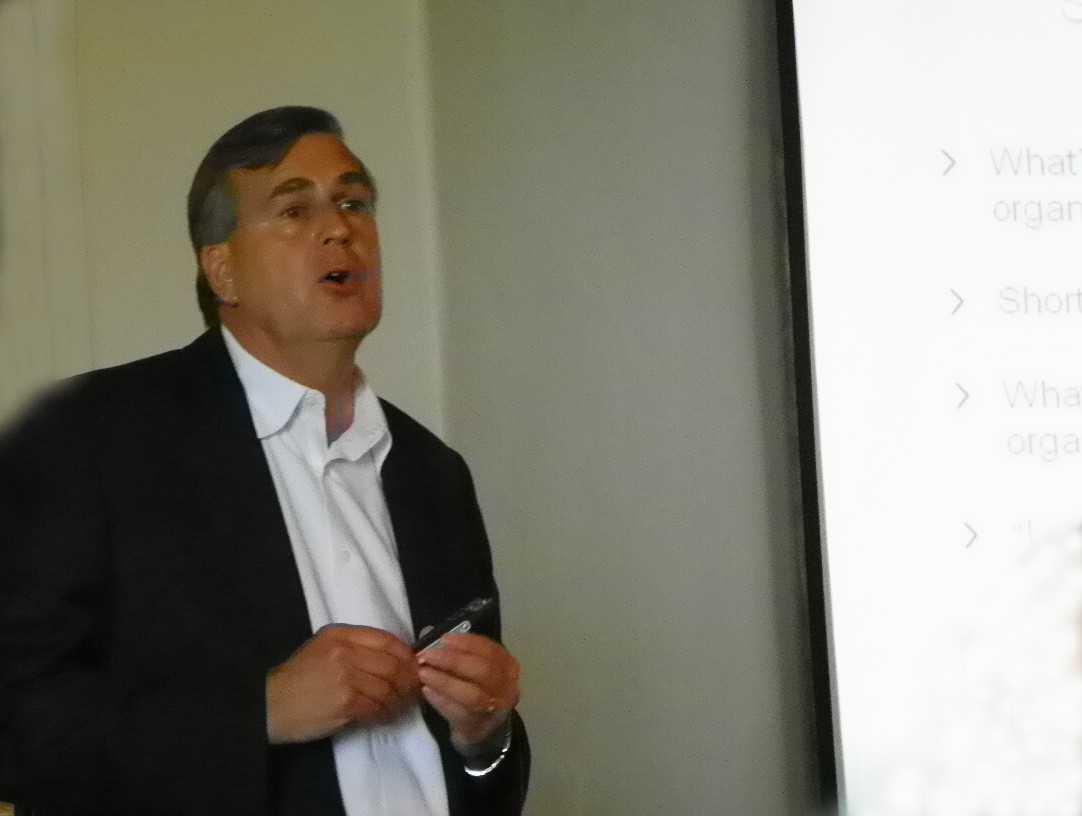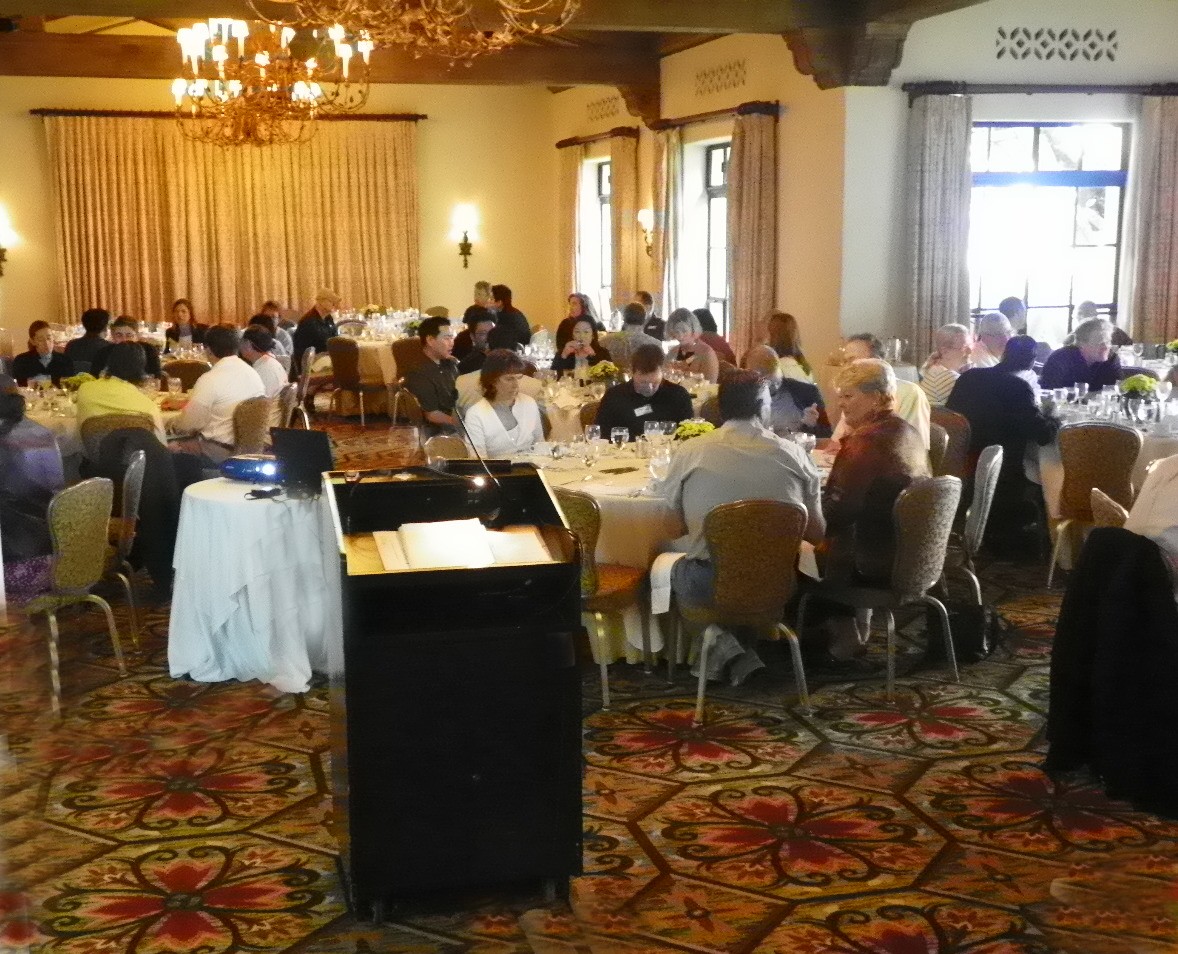Cloud computing and social networking elicit the most interest as companies consider ways to leverage mass appeal by Facebook, Twitter, YouTube, and other online social networking services.
More than 50 CIOs and other C-level delegates from throughout California gathered in Santa Barbara earlier this month to wrestle with the many dramatic changes taking place within IT and to share their ideas on how to tackle pressing issues, such as IT budget cuts, cloud computing, and social networking.
Dubbed the Future of Flexible Infrastructure, the conference was sponsored by Woodland Hills-based systems integrator Key Information Systems, an IBM Premier Business Partner, and held at the renowned Four Seasons Resort, The Biltmore Santa Barbara. The Pacific Coast setting was an appropriate locale for one of the conference's keynote speakers, Los Angeles Lakers legend Jerry West, whose image today is still embedded into the logo of the 2010 NBA championship team.
In fact, West's inspirational speech to the IT leaders was moved from an evening keynote to a breakfast speech because of Lakers business in Los Angeles the night before. West gave the attendees a taste of what being a leader in your organization means, a role that CIOs are being asked to step up to today more than ever before.

Conference photos, Dennis Fletcher
Figure 1: Lakers basketball legend Jerry West addresses CIO conference attendees.
In a wrap-up session for the attendees just prior to West's talk, Calvin Carr, vice president of sales for the Oak Hill Corp. of Santa Clara, discussed the role of CIOs in today's corporate environment and challenged them to focus on issues cited in a recent Wall Street Journal article titled "Why CIOs Are Last Among Equals."
"What can you take away from this retreat to help you become a stronger leader, a more strategic thinker, a better problem solver—a thought leader and influencer?" Carr asked the attendees. Weaving several themes that emerged from the conference during the previous day's 25 expert-led sessions, Carr outlined what traits, skills, and behaviors CIOs need in order to step up to today's challenges.
"How do you apply what you've heard at this event to establish you as a leader?" asked Carr. "Step forward, lead discussions, and use relevant examples," he said. "Cloud computing isn't just leveraging a software package; it's a new way to organize your infrastructure."

Figure 2: Calvin Carr, vice president of Oak Hill Corp., sums up a day of 25 sessions ranging from cloud computing to social networking.
The problem it seems, according to several professors from California's Santa Clara University, who authored the Wall Street Journal article, is that CIOs are not perceived as being leaders.
"Chief information officers are more important than ever to the success of their companies, given the crucial role information technology has come to play in every aspect of business. But in most companies, the CIO still isn't viewed as a peer by other senior executives, who tend to see CIOs as specialists lacking the full set of broad management skills," the article states.
What is preventing CIOs from taking their rightful place as powerful leaders in the corporation? According to the authors, it's a shortage of understanding of the business as a whole, an absence of strategic vision, and insufficient interpersonal skills to run a company. The good news is these are all talents that can be learned, according to the authors. In their defense, CIOs and IT managers are not hopelessly trapped in a "narrowly analytical mindset" as their peers believe; in fact, they are highly pragmatic and display the very type of thinking styles that CEOs say they want in a senior executive, say the authors.
One of the problems expressed by attendees at the conference was a sense that they are usually in a "reactive" mode and never get a chance to do any strategic thinking. It was clear at the end of three days, however, that the roles of CIOs, IT managers, and IT in general are or will be changing in the next several years. As the technology has become more reliable—reducing the role of IT as problem-solver—the technology also has become more complex. And it's going to get a lot more complex in the future. Despite the strides by IBM and other vendors to simplify the hardware and software solutions with an autonomic approach, the integration of various platforms in a virtualized environment using different Web 2.0 technologies has created a highly sophisticated—some would say even delicate—environment that requires a deep level of understanding to establish and monitor. While the result may be simpler, enhanced ease of use for the end users, sustaining the infrastructure under the covers requires a great deal of knowledge and experience of technology by the IT department.
Key's president Lief Morin told attendees they were experiencing a period of change in the information technology industry that was almost unprecedented. Many companies are consolidating, with larger companies buying smaller ones. Cloud computing and social networking were also having a great impact.

Figure 3: Conference sessions were small and intimate to encourage CIOs to be candid about their concerns.
Clearly one of the leading themes of the conference was the emerging role of cloud computing with the cost-saving enticements and enterprise flexibility it appears to offer. Balance this against a scary threat of attack from individuals and malware on the Internet, and you have an intoxicatingly dangerous seductress that requires a steady and experienced hand. The problem is, few companies have much experience with cloud computing, so there's a potential for them to get in over their head. The advice from Gartner and others seems to be start slowly with a "private cloud" that consumes three-fourths of a cloud budget and devote a small share to experimenting with the public cloud. The latter implies relying upon applications and data that are "off premises" and available with a browser. But who knows whether the third-party firm residing off premises is trustworthy and knowledgeable enough to safeguard a business's precious data. And is your data even stored in your own country? Perhaps the most disturbing question raised by attendees when discussing cloud computing is: what happens if and when you want to get off the cloud or change providers?
"I'm not moving to the cloud without an exit strategy," one attendee said at a session as the others nodded in agreement. The concern about what happens if something goes wrong and the cloud provider either loses, corrupts, or can't provide access to your data brought to mind the sense of helplessness faced by the government and rest of the country in the face of the still-leaking Gulf oil spill.
"You're going to want a throat to choke," said one attendee, referring to the possibility that some cloud providers could have their servers, their personnel, and your data in a foreign country or at least a remote location. Having a responsible human being nearby and accessible seemed to have much appeal to everyone present when discussing a third-party cloud provider.
While the sessions covered many of today's leading technology questions—from storage management to virtualization, networking to security—the topic that surprised organizers as being absolutely the most popular during the retreat was that of social networking and its emerging role in the organization. As many companies today restrict access to social networks such as Facebook, believing that employees are wasting corporate time and resources accessing such sites, the prevailing view that emerged from the conference was: if you can't beat them, join them.
"IT cannot control social networking, but it can add value by offering business intelligence," said Pete Elliot, director of marketing for Key Information Systems. "IT has to be relevant with what is going on with social networking, and it has an opportunity to manage the compliance issues," he said.
The comment summed up the experience of an attendee from Microsoft, who said employees actively sought the involvement of the Microsoft IT department by soliciting its help with analyzing information mined on the social networking sites. There are now 400 million people on Facebook, a population larger than that of the United States. Collecting and analyzing information from this huge organism takes the kind of tools that IT knows how to use. Often, a company's marketing department will launch a corporate page on Facebook or another social networking site, without informing IT. Attendees clearly were anxious about such independent behavior for security reasons if none other. Attendees agreed that social networking sites do raise both internal and external security questions as members tend to blur their personal and business lives online. An IBM representative said that the company warns employees that if they identify themselves online as IBM employees, then what they say in the social networking site could affect their employment.

Figure 4: Conference attendees have breakfast together before hearing from Calvin Car and Jerry West. Some stayed on to enjoy post-conference recreational activities, including sailing off the coast of Santa Barbara.
Other popular social networking sites that the IT professionals weren't quite sure what to do about were Facebook, LinkedIn, Plaxo, and the usual list of suspects. Twitter, for example, has experienced unprecedented growth in the past three years, moving from some 5,000 tweets a day in 2007 to 300,000 daily in 2008, 2.5 million a day in 2009, and 45 million tweets daily today. Consumer use of social networking sites has doubled in the past year as users spend an increasing number of hours posting and reading information from other users, going from three hours to six hours for those users who use the sites. Video is becoming an increasingly popular medium online and is expected to account for 90 percent of consumer IP traffic by 2013.
A number of corporations have channeled employees' urge to use social networking sites by substituting ones that it knows are secure and that it controls. One healthcare CIO said he implemented Yammer, which is a secure Twitter-type product for the enterprise. Moving to it was well received, he said, and diminished employees' reliance on email for all their communications. He also said he could easily get a "pulse of the company" by following the posts on Yammer. IBM Lotus Connections is a Facebook-type product for the enterprise and one of the fastest-growing segments of the company's product line. The appeal of the Lotus products is largely because IT can be assured they are secure, whereas consumer products are not.
Other concerns the IT leaders had were software licensing in a virtualized environment, remote desktop support where no technical staff is available (leading to a discussion of the benefits and drawbacks of a virtual desktop infrastructure), security of a virtualized environment, having employees share responsibility for enterprise security, IBM's new line of high-powered enterprise x86 servers, Intel's next generation of processors, virtualization limitations on VMware solutions.
Interestingly, there was very little discussion of IBM i and the operating system's benefits and drawbacks. Many of the participants, however, said they "grew up" on the AS/400 and acknowledged having in-house RPG programmers doing maintenance work on various IBM i mission-critical applications that they confided they wished they could find a way to replace. The problem? Most of the programmers keeping the larger applications running were in their fifties. They expressed a fear that when they retired, there simply won't be anyone available to replace them.
Though this was the first such CIO retreat sponsored by Key Info, the company expressed satisfaction with the outcome, so hopes for another look promising. The company expressed its appreciation to the 25 speakers from IBM, Microsoft, Symantec, VMware, NetApp, Cisco, and other firms that sent representatives to participate in the sessions, Dr. James Canton of the Institute for Global Futures, who gave a keynote speech, and Jerry West, executive director of the Northern Trust Open (formerly the L.A. Open), whose work on behalf of the group has raised millions of dollars for charity. Hopefully, next year will be a follow-on conference that exceeds everyone's wildest expectations.

Photo by Chris Smith
Figure 5: From left, Lief Morin, president of Key Information Systems; Jerry West, Lakers basketball legend; Pete Elliot, Key's director of marketing; Calvin Carr, vice president Oak Hill Corp.






















 More than ever, there is a demand for IT to deliver innovation. Your IBM i has been an essential part of your business operations for years. However, your organization may struggle to maintain the current system and implement new projects. The thousands of customers we've worked with and surveyed state that expectations regarding the digital footprint and vision of the company are not aligned with the current IT environment.
More than ever, there is a demand for IT to deliver innovation. Your IBM i has been an essential part of your business operations for years. However, your organization may struggle to maintain the current system and implement new projects. The thousands of customers we've worked with and surveyed state that expectations regarding the digital footprint and vision of the company are not aligned with the current IT environment. TRY the one package that solves all your document design and printing challenges on all your platforms. Produce bar code labels, electronic forms, ad hoc reports, and RFID tags – without programming! MarkMagic is the only document design and print solution that combines report writing, WYSIWYG label and forms design, and conditional printing in one integrated product. Make sure your data survives when catastrophe hits. Request your trial now! Request Now.
TRY the one package that solves all your document design and printing challenges on all your platforms. Produce bar code labels, electronic forms, ad hoc reports, and RFID tags – without programming! MarkMagic is the only document design and print solution that combines report writing, WYSIWYG label and forms design, and conditional printing in one integrated product. Make sure your data survives when catastrophe hits. Request your trial now! Request Now. Forms of ransomware has been around for over 30 years, and with more and more organizations suffering attacks each year, it continues to endure. What has made ransomware such a durable threat and what is the best way to combat it? In order to prevent ransomware, organizations must first understand how it works.
Forms of ransomware has been around for over 30 years, and with more and more organizations suffering attacks each year, it continues to endure. What has made ransomware such a durable threat and what is the best way to combat it? In order to prevent ransomware, organizations must first understand how it works. Disaster protection is vital to every business. Yet, it often consists of patched together procedures that are prone to error. From automatic backups to data encryption to media management, Robot automates the routine (yet often complex) tasks of iSeries backup and recovery, saving you time and money and making the process safer and more reliable. Automate your backups with the Robot Backup and Recovery Solution. Key features include:
Disaster protection is vital to every business. Yet, it often consists of patched together procedures that are prone to error. From automatic backups to data encryption to media management, Robot automates the routine (yet often complex) tasks of iSeries backup and recovery, saving you time and money and making the process safer and more reliable. Automate your backups with the Robot Backup and Recovery Solution. Key features include: Business users want new applications now. Market and regulatory pressures require faster application updates and delivery into production. Your IBM i developers may be approaching retirement, and you see no sure way to fill their positions with experienced developers. In addition, you may be caught between maintaining your existing applications and the uncertainty of moving to something new.
Business users want new applications now. Market and regulatory pressures require faster application updates and delivery into production. Your IBM i developers may be approaching retirement, and you see no sure way to fill their positions with experienced developers. In addition, you may be caught between maintaining your existing applications and the uncertainty of moving to something new. IT managers hoping to find new IBM i talent are discovering that the pool of experienced RPG programmers and operators or administrators with intimate knowledge of the operating system and the applications that run on it is small. This begs the question: How will you manage the platform that supports such a big part of your business? This guide offers strategies and software suggestions to help you plan IT staffing and resources and smooth the transition after your AS/400 talent retires. Read on to learn:
IT managers hoping to find new IBM i talent are discovering that the pool of experienced RPG programmers and operators or administrators with intimate knowledge of the operating system and the applications that run on it is small. This begs the question: How will you manage the platform that supports such a big part of your business? This guide offers strategies and software suggestions to help you plan IT staffing and resources and smooth the transition after your AS/400 talent retires. Read on to learn:
LATEST COMMENTS
MC Press Online